technical data SKODA FABIA 2010 2.G / 5J Service Manual
[x] Cancel search | Manufacturer: SKODA, Model Year: 2010, Model line: FABIA, Model: SKODA FABIA 2010 2.G / 5JPages: 244, PDF Size: 29.53 MB
Page 82 of 244

Heating and air conditioning system
81
Using the system
Safety
Driving Tips
General Maintenance
Breakdown assistance
Technical Data
HeatingUsing the system The heating system delivers air into the interior of the vehicle and warms it as required.Setting temperature– Turn the control dial
fig. 90
to the right in order to increase the temperature.
– Turn the control dial to the left in order to increase the temperature.Controlling blower– Turn the blower switch into one of the po
sitions, 1 to 4, in order to switch the
blower on.
– Turn the blower switch into position 0 in order to switch the blower off.– If you wish to shut off the fresh air supply
, use the button - recirculated air mode
page 80.
Control for air distribution– You can adjust the direction of the air
flow using the air distribution control
page 80.
Rear window heater– Press button . Further information
page 54, “Rear window heater”.
The air inlet in front of the windscreen must be free of ice, snow or leaves in order to ensure that the heating and ventilation systems operate properly. All controls apart from the control dial
can be set to any desired intermediate posi-
tion. The heating effect is dependent upon the c
oolant temperature, thus full heat output
only occurs when the engine has reached its operating temperature. The blower should aways be on to
prevent the windows from misting up.
Note
If the air distribution is positioned toward
s the windows, the total amount of air is
used to defrost the windows and thus no air will be fed to the footwell. This can lead to restriction of the heating comfort.
The used air streams out through the air removal openings in the luggage
compartment.
Fig. 90 Heating: Control elements
AAAAABAB
A1
AC
A2
AB
s3j8.a.book Page 81 Tuesday, April 20, 2010 1:10 PM
Page 84 of 244

Heating and air conditioning system
83
Using the system
Safety
Driving Tips
General Maintenance
Breakdown assistance
Technical Data
Climatic (semi-automatic air conditioning system)*Description Climatic is a combined cooling an
d heating system with electronic
control of the convenience temperature in the vehicle interior. It makes it possible to optimally control the air temperature at any season of the year.Description of the Climatic It is important for your safety and for your
driving comfort that the Climatic is operating
properly. The air conditioning system operates when switch
page 83, fig. 91
is
pressed and the following
conditions are met:
engine running,
outside temperature above +2°C and
blower switch switched on (positions 1 to 4).
If the cooling system is switched on, the temperature and air humidity drops in the vehicle. The wellbeing of the occupants of the
car is enhanced as a result of this partic-
ularly at high outside temperatures and a
high air humidity. The system prevents the
windows misting up during th
e cold season of the year.
The heating effect is dependent upon the c
oolant temperature, thus
full heat output
only occurs when the engine has reached its operating temperature. It is possible to briefly activate recirculat
ed air mode in order to enhance the cooling
effect
.
Air at a temperature of about 5°C may flow
out of the vents under certain circum-
stances when the cooling system is operatin
g. Lengthy and uneven distribution of the
air flow out of the vents (in particular at the leg area) and large differences in temper-ature, for example when getting out of the ve
hicle, can result in chills in sensitive
persons. The air inlet in front of the windscreen must
be free of ice, snow or leaves in order to
ensure that the heating and cooling systems operate properly.
After switching on the cooling
Condensation
from the evaporator of the air condi-
tioning may drip down and form a puddle be
low the vehicle. This is quite normal and
not an indication of a leak!
WARNING
For your own safety and that of other road users, ensure that all the
windows are free of ice, snow and misting. Please familiarize yourself about how to correctly operate
the heating and ventilation systems, how to demist
and defrost the windows, as well as with the cooling mode.
You should not leave recirculated air mode on over a longer period of time,
as “stale” air may result in fatigue in the driver and occupants, divert your attention and also cause the windows to mist up. The risk of having an accident increases. Switch recirculated air mo
de off as soon as the windows begin
misting up.
Note
We recommend that you do not smoke in
the vehicle when the recirculating air
mode is operating since the smoke which is drawn at the evaporator from the interior of the vehicle forms deposits in the evapor
ator of the air conditioning system. This
produces a permanent odour when the Climat
ic is operating which can only be elimi-
nated through considerable effort and
expense (replacement of compressor).
Using the system
AC
AE
Fig. 91 Climatic: Control elements
s3j8.a.book Page 83 Tuesday, April 20, 2010 1:10 PM
Page 86 of 244
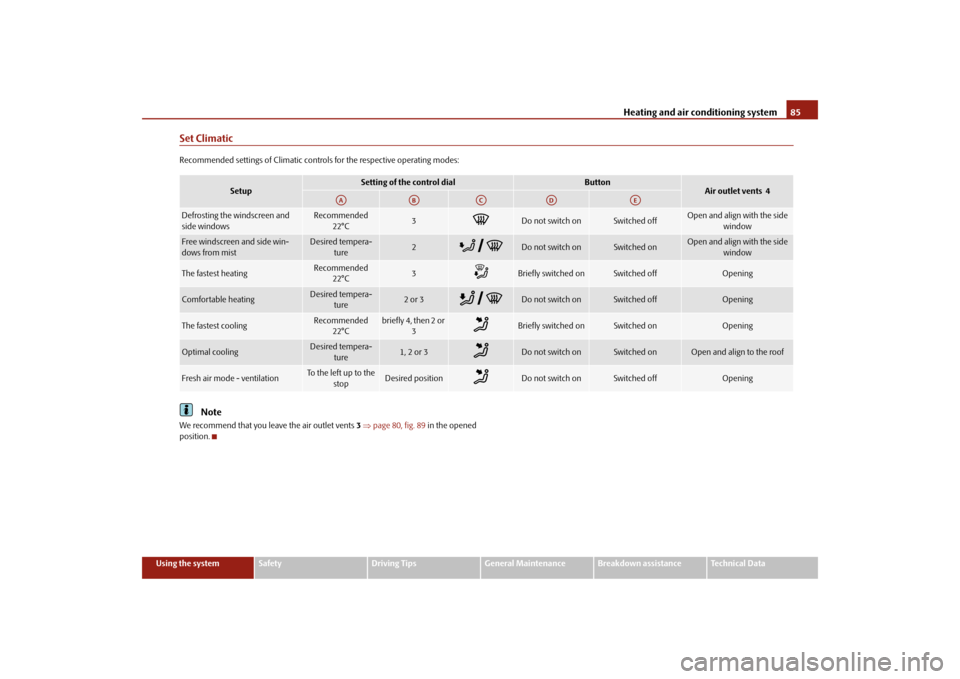
Heating and air conditioning system
85
Using the system
Safety
Driving Tips
General Maintenance
Breakdown assistance
Technical Data
Set ClimaticRecommended settings of Climatic contro
ls for the respective operating modes:
Note
We recommend that you leave the air outlet vents
3 page 80, fig. 89
in the opened
position.
Setup
Setting of the control dial
Button
Air outlet vents 4
Defrosting the windscreen and side windows
Recommended
22°C
3
Do not switch on
Switched off
Open and align with the side
window
Free windscreen and side win- dows from mist
Desired tempera-
ture
2
Do not switch on
Switched on
Open and align with the side
window
The fastest heating
Recommended
22°C
3
Briefly switched on
Switched off
Opening
Comfortable heating
Desired tempera-
ture
2 or 3
Do not switch on
Switched off
Opening
The fastest cooling
Recommended
22°C
briefly4, then 2or
3
Briefly switched on
Switched on
Opening
Optimal cooling
Desired tempera-
ture
1, 2 or 3
Do not switch on
Switched on
Open and align to the roof
Fresh air mode - ventilation
To the left up to the
stop
Desired position
Do not switch on
Switched off
Opening
AA
AB
AC
AD
AE
s3j8.a.book Page 85 Tuesday, April 20, 2010 1:10 PM
Page 88 of 244
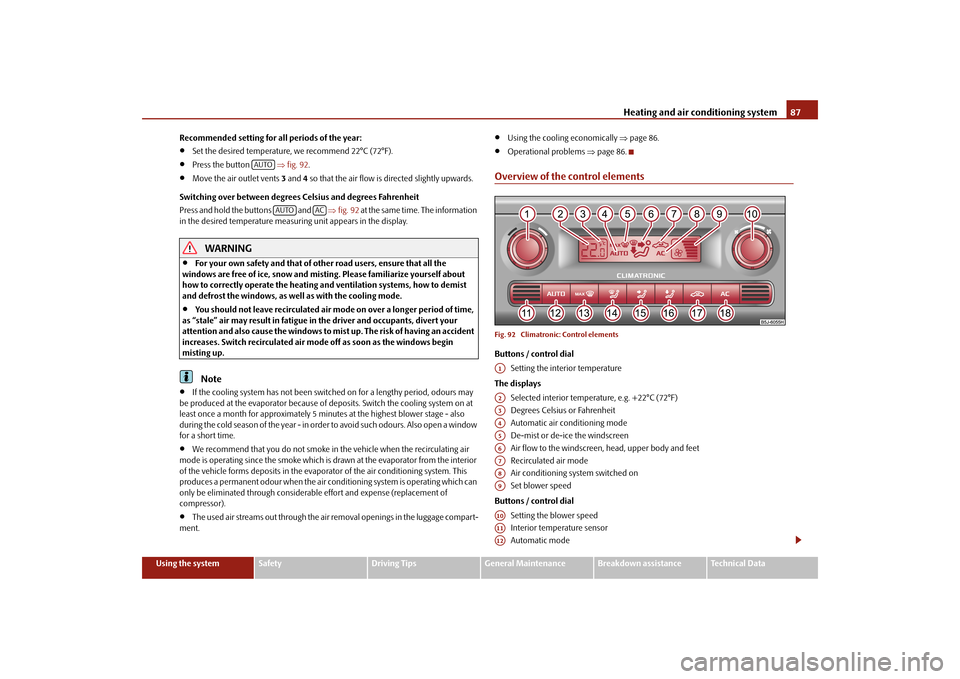
Heating and air conditioning system
87
Using the system
Safety
Driving Tips
General Maintenance
Breakdown assistance
Technical Data
Recommended setting for all periods of the year:
Set the desired temperature, we recommend 22°C (72°F).
Press the button
fig. 92
.
Move the air outlet vents
3 and
4 so that the air flow is
directed slightly upwards.
Switching over between degrees
Celsius and degrees Fahrenheit
Press and hold the buttons and
fig. 92
at the same time. The information
in the desired temperature measuring unit appears in the display.
WARNING
For your own safety and that of other road users, ensure that all the
windows are free of ice, snow and mistin
g. Please familiarize yourself about
how to correctly operate th
e heating and ventilation systems, how to demist
and defrost the windows, as well as with the cooling mode.
You should not leave recirculated air mode on over a longer period of time,
as “stale” air may result in fatigue in the driver and occupants, divert your attention and also cause the windows to mist up. The risk of having an accident increases. Switch recirculated air mode off as soon as the windows begin misting up.
Note
If the cooling system has not been switched on for a lengthy period, odours may
be produced at the evaporator because of
deposits. Switch the cooling system on at
least once a month for approximately 5 minut
es at the highest blower stage - also
during the cold se aso n of the y ear - i n o rde
r to avoid such odours. Also open a window
for a short time.
We recommend that you do not smoke in the vehicle when the recirculating air
mode is operating since the smoke which is drawn at the evaporator from the interior of the vehicle forms deposits in the evapor
ator of the air conditioning system. This
produces a permanent odour when the air co
nditioning system is operating which can
only be eliminated through considerable
effort and expense (replacement of
compressor).
The used air streams out through the air
removal openings in the luggage compart-
ment.
Using the cooling economically
page 86.
Operational problems
page 86.
Overview of the control elementsFig. 92 Climatronic: Control elementsButtons / control dial
Setting the interior temperature
The displays
Selected interior temperature, e.g. +22°C (72°F) Degrees Celsius or FahrenheitAutomatic air conditioning mode De-mist or de-ice the windscreen Air flow to the windscreen, head, upper body and feet Recirculated air mode Air conditioning sy
stem switched on
Set blower speed
Buttons / control dial
Setting the blower speed Interior temperature sensorAutomatic mode
AUTO
AUTO
AC
A1A2A3A4A5A6A7A8A9A10A11A12
s3j8.a.book Page 87 Tuesday, April 20, 2010 1:10 PM
Page 90 of 244

Starting-off and Driving
89
Using the system
Safety
Driving Tips
General Maintenance
Breakdown assistance
Technical Data
Starting-off and DrivingSetting steering wheel positionFig. 93 Adjustable steering wheel: Lever be
low the steering column / Safe distance to
steering wheelYou can set the height and the forward/back
position of the steering wheel to the
desired position. – Adjust the driver seat
page 59.
– Pull the lever below the steering wheel down
fig. 93
- left
.
– Set the steering wheel to the desired position (concerning height and forward/back
position).
– Then push the lever up against the steering column until it locks into place.
WARNING
You must not adjust the steering wheel when the vehicle is moving!
The driver must maintain a distance of
at least 25 cm to
the steering wheel
fig. 93
- right. Not maintaining this minimum distance will mean that the
airbag system will not be able to properly protect you - hazard!
For safety reasons the lever must always be firmly pushed up to avoid the
steering wheel altering its po
sition unintentionally when driving - risk of acci-
dent!
If you adjust the steering wheel furthe
r towards the head, you will reduce
the protection offered by the driver airbag in the event of an accident. Check that the steering wheel is
aligned to the chest.
When driving, hold the steering wheel
with both hands firmly on the outer
edge in the 9 o'clock and 3 o'clock po
sition. Never hold the steering wheel
firmly in the 12 o'clock position or in another way (e.g. in the middle of the steering wheel or at the inne
r steering wheel edge). In such
cases, injuries to the
arms, the hands and the head can occur
when the driver airbag is deployed.
Ignition lockPetrol engines - ignition switched off, engine
off, the steering can be locked.
- ignition switched on - start engine Diesel engines - interruption of fuel supply, ignition swit
ched off, engine off, the steering can be
locked. - heating glow plugs on, ignition switched onWARNING (continued)
Fig. 94 Ignition lock positions
A1A2A3A1A2
s3j8.a.book Page 89 Tuesday, April 20, 2010 1:10 PM
Page 92 of 244

Starting-off and Driving
91
Using the system
Safety
Driving Tips
General Maintenance
Breakdown assistance
Technical Data
Avoid high engine revolutions, full throttle and high engine loads as long as the
engine has not yet reached its normal oper
ating temperature - risk of damaging the
engine!
Vehicles which are fitted with an exhaust gas catalytic converter should not be tow-
started over a distance of more than 50 metres.
For the sake of the environment
Never warm up the engine when the vehicle is standing. Drive off right away. When driving the engine reaches its operating te
mperature more rapidly and the pollutant
emissions are lower.Petrol enginesThese engines are fitted with a starter system which selects the correct fuel-air mixture for every external air temperature.
Do not operate accelerator before and when starting engine.
Interrupt the attempt at starting after 10
seconds if the engine does not start right
awayand wait for about 30 seconds before repeating the attempt.
It is possible that the fuse on the electric
al fuel pump is defect if the engine still
does not start. Check the fuse and replace it if necessary
page 195.
If the engine does not start, contact the nearest specialist garage to obtain profes-
sional assistance. It may be necessary, if the engine is
very hot
, to slightly depress the accelerator after
the engine has started.Diesel enginesGlow plug system Diesel engines are equipped with a glow
plug system, the preglow period being
controlled automatically in line with the coolant temperature and outside tempera- ture. The preglow indicator light
comes on after the ignition has been switched on.
You should not switch on any major electrical components during the heating period otherwise the vehicle battery will be drained unnecessarily.
You should start the engine immediately after the glow plug warning light
has
gone out.
The glow plug warning light will come on for about one second if the engine is at a
normal operating temperature or if the outside temperature is above +5°C. This means that you can start the engine
right away
.
Interrupt the attempt at starting after 10 seconds if the engine does not start right
awayand wait for about 30 seconds before repeating the attempt.
It is possible that the fuse
on the diesel preglow system is defect if the engine still
does not start. Check the fuse and replace it if necessary
page 195.
Contact the nearest specialist garage to obtain professional assistance.
Starting the engine after fuel tank has run dry It may take longer than normal to start the
engine after refuelling if the fuel tank has
run completely dry - up to one minute. This is
because the fuel system must first of all
be filled while the attempting to start the engine.Switching off the engine– The engine can be switched off by turnin
g the ignition key from position into
page 89, fig. 94
.
WARNING
Never switch off the engine before the ve
hicle is stationary - risk of accident!
The brake booster only operates when the engine is running. Greater phys-
ical effort for braking is required when en
gine is switched off.
Because if you do
not stop as normal, this can cause an accident and severe injuries.
Caution
you should not switch the engine off right away at the end of your journey after the engine has been operated for a lengthy period
at high loads but should be allowed it
to run at idling speed for about 2 minutes.
This prevents any accumulation of heat
when the engine is switched off.
A1
s3j8.a.book Page 91 Tuesday, April 20, 2010 1:10 PM
Page 94 of 244
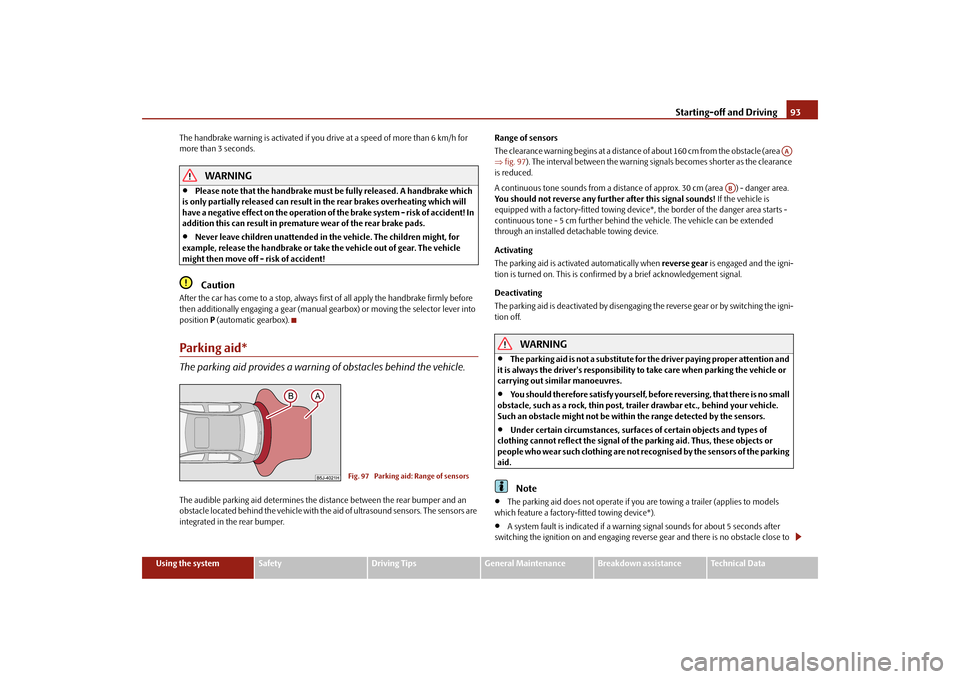
Starting-off and Driving
93
Using the system
Safety
Driving Tips
General Maintenance
Breakdown assistance
Technical Data
The handbrake warning is acti
vated if you drive at a speed of more than 6 km/h for
more than 3 seconds.
WARNING
Please note that the handbrake must be fully released. A handbrake which
is only partially released can result in the rear brakes overheating which will have a negative effect on the operation of
the brake system - risk of accident! In
addition this can result in premature wear of the rear brake pads.
Never leave children unattended in the vehicle. The children might, for
example, release the handbrake or take
the vehicle out of gear. The vehicle
might then move off - risk of accident!
Caution
After the car has come to a stop, always firs
t of all apply the handbrake firmly before
then additionally engaging a gear (manual gearbox) or moving the selector lever into position
P (automatic gearbox).
Parking aid*The parking aid provides a warning of obstacles behind the vehicle.The audible parking aid determines the di
stance between the rear bumper and an
obstacle located behind the vehicle with the
aid of ultrasound sensors. The sensors are
integrated in the rear bumper.
Range of sensors The clearance warning begins at a distance
of about 160 cm from the obstacle (area
fig. 97
). The interval between the warning si
gnals becomes shorter as the clearance
is reduced. A continuous tone sounds from
a distance of approx. 30
cm (area ) - danger area.
You should not reverse any further after this signal sounds!
If the vehicle is
equipped with a factory-fitted
towing device*, the border of the danger area starts -
continuous tone - 5 cm further behind th
e vehicle. The vehicle can be extended
through an installed deta
chable towing device.
Activating The parking aid is activated automatically when
reverse gear
is engaged and the igni-
tion is turned on. This
is confirmed by a brief acknowledgement signal.
Deactivating The parking aid is deactivated by disengaging the reverse gear or by switching the igni- tion off.
WARNING
The parking aid is not a substitute for
the driver paying proper attention and
it is always the driver's responsibility
to take care when parking the vehicle or
carrying out similar manoeuvres.
You should therefore satisfy yourself, before reversing, that there is no small
obstacle, such as a rock, thin post, trai
ler drawbar etc., behind your vehicle.
Such an obstacle might not be within the range detected by the sensors.
Under certain circumstances, surfaces of certain objects and types of
clothing cannot reflect the signal of the parking aid. Thus, these objects or people who wear such clothing are not recognised by the sensors of the parking aid.
Note
The parking aid does not operate if you
are towing a trailer (applies to models
which feature a factory-fitted towing device*).
A system fault is indicated if a warning signal sounds for about 5 seconds after
switching the ignition on and engaging reverse gear and there is no obstacle close to
Fig. 97 Parking aid: Range of sensors
AA
AB
s3j8.a.book Page 93 Tuesday, April 20, 2010 1:10 PM
Page 96 of 244
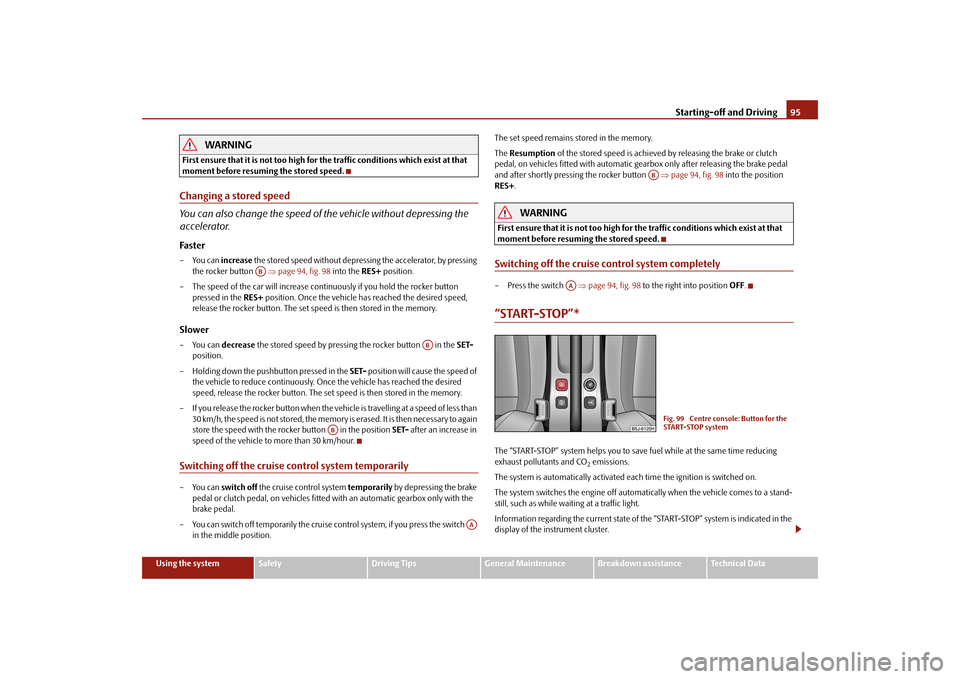
Starting-off and Driving
95
Using the system
Safety
Driving Tips
General Maintenance
Breakdown assistance
Technical Data
WARNING
First ensure that it is not too high for the traffic conditions which exist at that moment before resuming the stored speed.Changing a stored speed You can also change the speed of
the vehicle without depressing the
accelerator.Fa s t e r–You can
increase
the stored speed without depressing the accelerator, by pressing
the rocker button
page 94, fig. 98
into the
RES+
position.
– The speed of the car will increase cont
inuously if you hold the rocker button
pressed in the
RES+
position. Once the vehicle ha
s reached the desired speed,
release the rocker button. The set speed is then stored in the memory.
Slower–You can
decrease
the stored speed by pressing the rocker button in the
SET-
position.
– Holding down the pushbutton pressed in the
SET-
position will cause the speed of
the vehicle to reduce continuously. On
ce the vehicle has reached the desired
speed, release the rocker button. The set speed is then stored in the memory.
– If you release the rocker button when the vehicle is travelling at a speed of less than
30 km/h, the speed is not stored, the memory is erased. It is then necessary to again store the speed with the rocker button in the position
SET-
after an increase in
speed of the vehicle to more than 30 km/hour.
Switching off the cruise control system temporarily–You can
switch off
the cruise control system
temporarily
by depressing the brake
pedal or clutch pedal, on vehicles fitted
with an automatic gearbox only with the
brake pedal.
– You can switch off temporarily the cruise control system, if you press the switch
in the middle position.
The set speed remains stored in the memory. The
Resumption
of the stored speed is achieved by releasing the brake or clutch
pedal, on vehicles fitted with automatic
gearbox only after releasing the brake pedal
and after shortly pressing the rocker button
page 94, fig. 98
into the position
RES+
.WARNING
First ensure that it is not too high for the traffic conditions which exist at that moment before resuming the stored speed.Switching off the cruise control system completely– Press the switch
page 94, fig. 98
to the right into position
OFF
.
“START-STOP”*The “START-STOP” system helps you to save
fuel while at the same time reducing
exhaust pollutants and CO
2 emissions.
The system is automatically activated ea
ch time the ignition
is switched on.
The system switches the engine off automa
tically when the vehicle comes to a stand-
still, such as while wa
iting at a traffic light.
Information regarding the current state of the “START-STOP” system is indicated in the display of the instrument cluster.
AB
AB
AB
AA
AB
AA
Fig. 99 Centre console: Button for the START-STOP system
s3j8.a.book Page 95 Tuesday, April 20, 2010 1:10 PM
Page 98 of 244
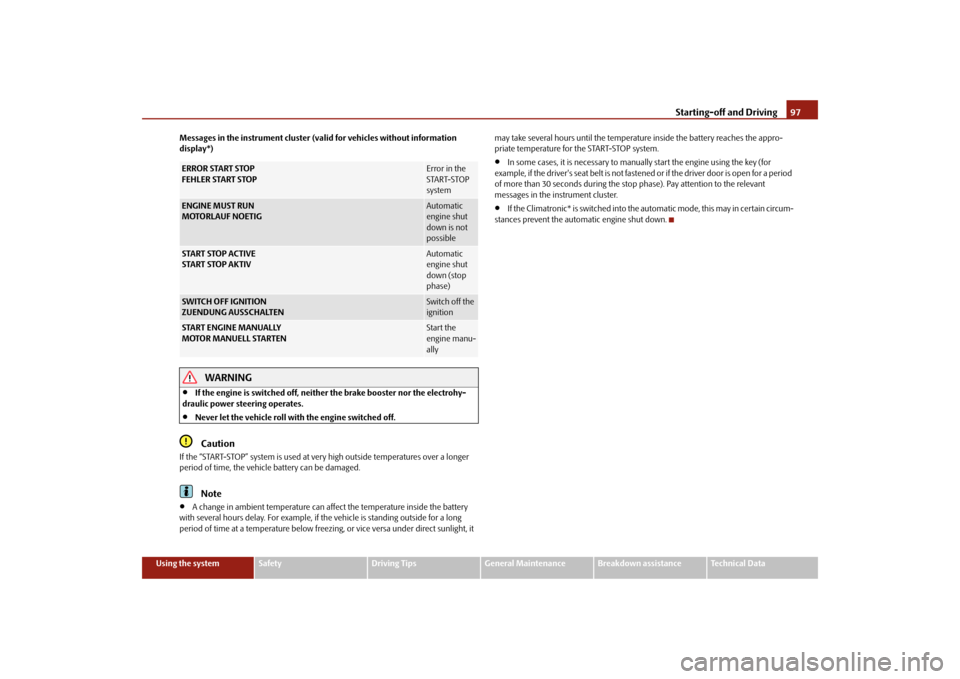
Starting-off and Driving
97
Using the system
Safety
Driving Tips
General Maintenance
Breakdown assistance
Technical Data
Messages in the instrument cluster (valid for vehicles without information display*)
WARNING
If the engine is switched off, neit
her the brake booster nor the electrohy-
draulic power steering operates.
Never let the vehicle roll wi
th the engine switched off.
Caution
If the “START-STOP” system is used at very
high outside temperatures over a longer
period of time, the vehicl
e battery can be damaged.
Note
A change in ambient temperature can affect the temperature inside the battery
with several hours delay. For example, if
the vehicle is standing outside for a long
period of time at a temperature below freezi
ng, or vice versa under
direct sunlight, it
may take several hours until the temperat
ure inside the battery reaches the appro-
priate temperature for the START-STOP system.
In some cases, it is necessary to manually start the engine using the key (for
example, if the driver's seat belt is not fastened or if the driver door is open for a period of more than 30 seconds during the stop
phase). Pay attention to the relevant
messages in the instrument cluster.
If the Climatronic* is switched into the automatic mode, this may in certain circum-
stances prevent the automatic engine shut down.
ERROR START STOP FEHLER START STOP
Error in the START-STOP system
ENGINE MUST RUN MOTORLAUF NOETIG
Automatic engine shut down is not possible
START STOP ACTIVE START STOP AKTIV
Automatic engine shut down (stop phase)
SWITCH OFF IGNITION ZUENDUNG AUSSCHALTEN
Switch off the ignition
START ENGINE MANUALLYMOTOR MANUELL STARTEN
Start the engine manu- ally
s3j8.a.book Page 97 Tuesday, April 20, 2010 1:10 PM
Page 100 of 244
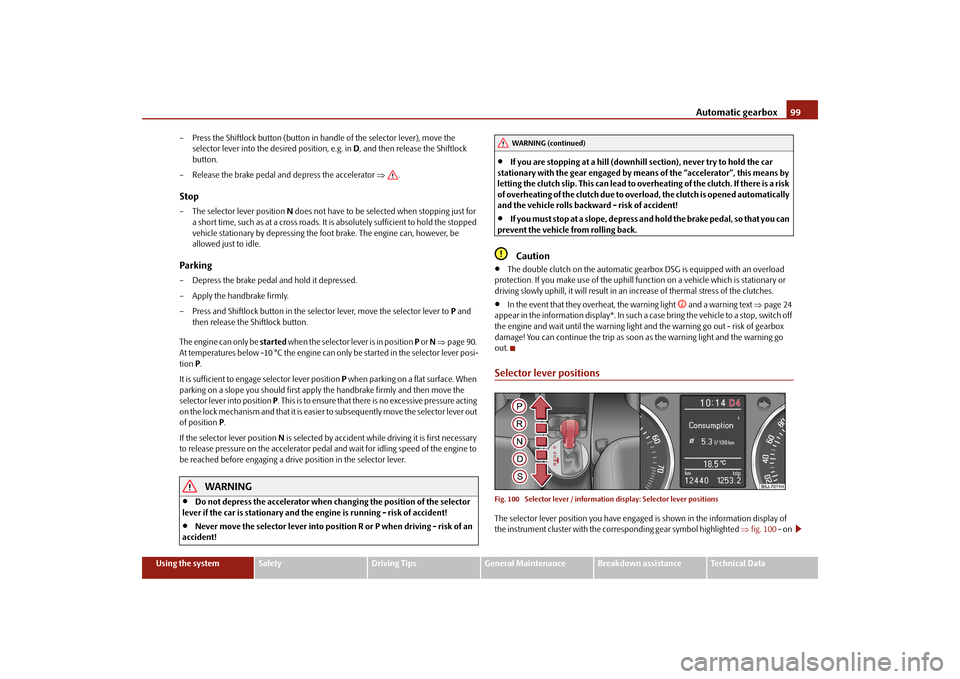
Automatic gearbox
99
Using the system
Safety
Driving Tips
General Maintenance
Breakdown assistance
Technical Data
– Press the Shiftlock button (button in ha
ndle of the selector lever), move the
selector lever into the desired position, e.g. in
D, and then release the Shiftlock
button.
– Release the brake pedal and depress the accelerator
.
Stop– The selector lever position
N does not have to be selected when stopping just for
a short time, such as at a cross roads. It is absolutely sufficient to hold the stopped vehicle stationary by depressing the foot
brake. The engine can, however, be
allowed just to idle.
Parking– Depress the brake pedal and hold it depressed. – Apply the handbrake firmly.– Press and Shiftlock button in the selector lever, move the selector lever to
P and
then release the Shiftlock button.
The engine can only be
started
when the selector lever is in position
P or N page 90.
At temperatures below -10 °C the engine can only be started in the selector lever posi- tion
P.
It is sufficient to engage selector lever position
P when parking on a flat surface. When
parking on a slope you should first apply
the handbrake firmly and then move the
selector lever into position
P. This is to ensure that there is no excessive pressure acting
on the lock mechanism and that it is easier to subsequently move the selector lever out of position
P.
If the selector lever position
N is selected by accident while driving it is first necessary
to release pressure on the accelerator pedal and wait for idling speed of the engine to be reached before engaging a drive position in the selector lever.
WARNING
Do not depress the accelerator when changing the position of the selector
lever if the car is stationary and the
engine is running - risk of accident!
Never move the selector lever into position R or P when driving - risk of an
accident!
If you are stopping at a hill (downhill section), never try to hold the car
stationary with the gear engaged by mean
s of the “accelerator”, this means by
letting the clutch slip. This can lead to ov
erheating of the clutch
. If there is a risk
of overheating of the clutch due to overlo
ad, the clutch is op
ened automatically
and the vehicle rolls backward - risk of accident!
If yo u m us t s to p a t a sl ope , d e pre s s a nd ho ld t he b ra ke pe d a l , s o t ha t y ou c a n
prevent the vehicle from rolling back.
Caution
The double clutch on the automatic gear
box DSG is equipped with an overload
protection. If you make use of the uphill func
tion on a vehicle which is stationary or
driving slowly uphill, it will result in an
increase of thermal stress of the clutches.
In the event that they overheat, the warning light
and a warning text
page 24
appear in the information display*. In such a case bring the vehicle to a stop, switch off the engine and wait until the warning light and the warning go out - risk of gearbox damage! You can continue the trip as soon as the warning light and the warning go out.Selector lever positionsFig. 100 Selector lever / information display: Selector lever positionsThe selector lever position you have engaged is shown in the information display of the instrument cluster with the corr
esponding gear symbol highlighted
fig. 100
- on
WARNING (continued)
s3j8.a.book Page 99 Tuesday, April 20, 2010 1:10 PM